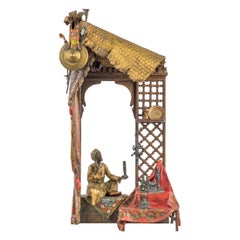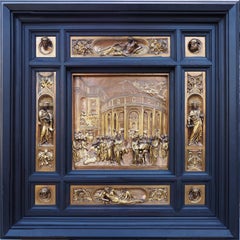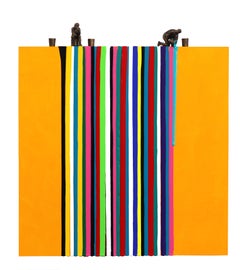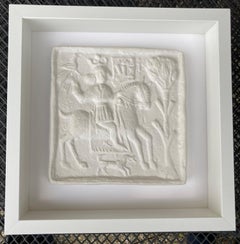Altar Figurative Sculptures
to
7
3
2
3
Overall Width
to
Overall Height
to
1
2
10
2
2
1
1
1
1
448
4,120
2,396
2,357
1,653
1,640
1,363
817
811
659
552
420
366
351
316
305
298
256
215
212
10
9
3
2
2
5
2
1
1
1
12
3
Art Subject: Altar
Agnus dei - Puerta de sagrario - Siglo XVII
Located in Sant Celoni, ES
Muy interesante puerta de sagrario de madera tallada y policromada del siglo xvii.
Es de comienzos del barroco, hay la representación del agnus dei con...
Category
17th Century Baroque Figurative Sculptures
Materials
Wood Panel
"Ex Nihilo", Frederick Hart, Bronze Sculpture, Figurative Woman & Men
Located in Dallas, TX
Very Rare! Ex Nihilo, working model, is the intermediate scale model for the full-scale plaster for the final stone sculpture of Ex Nihilo, commissioned as part of The Creation Sculptures at Washington National Cathedral...
Category
Early 2000s American Impressionist Figurative Sculptures
Materials
Bronze
Austrian Cold Painted Bronze by Bergmann
Located in New York, NY
FRANZ BERGMAN
Austrian, (1861-1936)
A Fine Quality Austrian cold-painted Bronze Table Lamp and Sculpture Depicting an Arab merchant, stamped...
Category
Early 20th Century Figurative Sculptures
Materials
Bronze
The Story of Joseph from the Second Baptistery Doors, Florence (“The Gates of Pa
Located in New York, NY
Ferdinand Barbedienne (Saint-Martin-de-Fresnay 1810 – 1892 Paris) after Lorenzo Ghiberti (Florence, 1378 – 1455)
Signed at the lower right of the principal relief: F. BARBEDIENNE
Provenance: Private Collection, USA.
Barbedienne’s “Gates of Paradise” reliefs are one of the triumphs of nineteenth-century bronze casting and patination. The nine panels that comprise our example are half-size reductions of the famous originals by Lorenzo Ghiberti, made for the Baptistery of Florence and now housed in the Museo del Opera del Duomo. Mounted in an impressive, mullioned frame surround, our work is an exceptional exemplar of the Renaissance Revival, the broadly influential style and movement that infused architecture, design, and artistic culture in the latter half of the nineteenth century.
The central scene, The Story of Joseph, is perhaps the most celebrated of the entire series depicting as it does seven episodes from the Biblical narrative integrated into a single composition: Joseph cast by his brethren into the well, Joseph sold to the merchants, the merchants delivering Joseph to the pharaoh, Joseph interpreting the pharaoh’s dream, the pharaoh paying him honor, Jacob sending his sons to Egypt, and Joseph recognizes his brothers and returns home. The surrounding reliefs—two vertical figures in niches, two recumbent figures, and four portrait heads in roundels—are as well faithful reductions of Ghiberti’s original bronzes on other parts of the doors.
The maker of these casts was the renowned 19th-century French fondeur Ferdinand Barbedienne. Gary Radke has recently written of this great enterprise:
“The Parisian bronze caster Ferdinand Barbedienne began making half-sized copies of ancient and Renaissance sculpture in the 1830s. His firm benefitted enormously from the collaboration of Achille Collas, whom Meredith Shedd has shown was one of numerous pioneers in the mechanical reproduction of sculpture. Their competitors largely devoted themselves to reproducing relief sculpture, but Collas devised a process for creating fully three-dimensional copies. A tracing needle, powered by a treadle, moved over the surface of a full-sized plaster cast or bronze of the original and triggered a complementary action in a cutting stylus set over a soft plaster blank…He signed an exclusive contract with Barbedienne on November 29, 1838, and won medals for his inventions in 1839 and 1844.
Barbedienne’s half-sized copies of the Gates of Paradise were famous not only for their fidelity to the original, but also for the way their gilding…suggested the glimmering surface that was hidden under centuries of dirt. Some critics even saw Collas’s and Barbedienne’s work as ‘philanthropic, an exemplary adaptation of industry to the requirements of art, the artist, the workers, and the public alike.’
At 25,000 francs, Collas’s and Barbedienne’s reduction of the Gates of Paradise was singularly more expensive than any other item for sale in their shop. All the reliefs, individual statuettes, and busts were cast separately and could be purchased either by the piece or as an ensemble. Fittingly, Barbedienne’s accomplishment earned him the Grand Prix at the 1878 Paris Exposition Universelle, along with numerous other medals.”
Three complete examples of the Barbedienne-Ghiberti doors are known. One, first installed in a chapel in the Villa Demidoff of San Donato near Pratolino, was later acquired by William Vanderbilt...
Category
Late 19th Century Figurative Sculptures
Materials
Bronze
Austrian Cold Painted Bronze by Bruno Zach
By Bruno Zach
Located in New York, NY
Cold Painted Austrian Bronze Table Lamp and Sculpture of a lounging Arab man.
Signed with one of Zach's pseudonyms "K. Salat"
Size: 16 1/2 inches high
Artist Bio:
Bruno Zach (6 Ma...
Category
Early 20th Century Art Deco Figurative Sculptures
Materials
Bronze
"Alhambra Facade Model", Early 20th Century Polychromed Stucco Plaque by R. Rus
Located in Madrid, ES
RAFAEL RUS ACOSTA
Spanish, Early 20th Century
ALHAMBRA FACADE MODEL PLAQUE
signed "Rafael Rus Acosta" (lower left), and inscribed "Granada" (lower righ...
Category
1920s Figurative Sculptures
Materials
Ceramic, Gesso
Austrian Cold Painted Bronze by Franz Bergmann
Located in New York, NY
FRANZ BERGMANN
Austrian, (1861-1936)
Praying at a Mosque
Cold-Painted Bronze Lamp and Sculpture of a man praying in front of a mosque.
30 inches high
Category
Early 20th Century Figurative Sculptures
Materials
Bronze
Austrian Cold Painted Bronze by Franz Bergmann
Located in New York, NY
FRANZ BERGMANN
Austrian, (1861-1936)
The Rug Merchant
18 inches high
Category
Early 20th Century Figurative Sculptures
Materials
Bronze
"Alhambra Facade Model", Early 20th Century Polychromed Stucco Plaque by R. Rus
Located in Madrid, ES
RAFAEL RUS ACOSTA
Spanish, Early 20th Century
ALHAMBRA FACADE MODEL PLAQUE
signed "Rafael Rus Acosta" (lower left), and inscribed "Granada" (lower righ...
Category
1920s Figurative Sculptures
Materials
Ceramic, Gesso
Austrian Cold Painted Bronze by Franz Bergmann
Located in New York, NY
FRANZ BERGMANN
Austrian, (1838-1894)
The Harem
Revolving figures of a man holding a sword and a seated half nude woman.
13 1/4 inches high
Category
Early 20th Century Figurative Sculptures
Materials
Bronze
Austrian Cold Painted Bronze by Franz Bergmann
Located in New York, NY
FRANZ BERGMANN
Austrian, (1838-1894)
Bath Tent
Two nude women in a bathing tent, reverse impressed with "B" within a vasiform mark for Franz Bergman.
17 1/2 inches high
Category
Early 20th Century Figurative Sculptures
Materials
Bronze
R.H. Ives Gammell Painted Bas Relief on Wood, 1947 - Lady of the Seven Sorrows
Located in Phoenix, AZ
Astounding painting and carving on wood panel by the “Hound of Heaven” artist Robert Gammell. Created 1947.
This beautiful work features rich color, gold accents and incredible detail.
Signed lower right “R.H. Ives Gammell” and dated ‘47.
The subject comes from the imagination of the artist and is titled “Lady of the Seven Sorrows.”
The work measures 34 1/2"h x 11 1/4"w and is considered to be one of the artist’s “Puppy Panels.” The ornate frame measures 38 1/2"h x 15 1/2"w x 1 1/4"d. The weight is 9 ½ pounds.
A label is attached to the verso listing the work as being an entry for the 1967 Grand National Show with the American Artists Professional League in New York.
This detailed and beautiful painting is a work to be treasured.
More Information Robert Hale Ives Gammell: After completing his major allegorical sequence, the Hound of Heaven, Gammell felt compelled to revisit certain themes and figurative compositions in later years. His original plan was to display the smaller panels, or "Puppy Panels" as he affectionately called them, between the larger Hound panels.
Robert Hale Ives Gammell (1893-1981) was a prolific professional painter working in Boston, Provincetown, and Williamstown, Massachusetts. During the sixty-five years of his career, Gammell painted murals, portraits, landscapes, and still lifes, but the pieces which excited him most were the allegorical works drawn from his imagination. In his diary Gammell wrote that he was “fascinated by the drama of man in his relationship to the forces of the universe and of his own nature.” Over the years he experimented using ancient myths and rituals as well as contemporary symbols in his attempts to articulate images of man’s terror, wonder and yearning in the face of a century of upheaval.
Excerpt from Elizabeth Ives Hunter, the God-daughter of R. H. Ives Gammell and the daughter of his assistant, Theodore W. J. Valsam.
R. H. Ives Gammell believed in the practice and standards of art should rest on the Gold standard established by the 19th-century French system of learning, as practiced by the Ecole des Beaux-Arts and Academie Julian of Paris. His personal mission was to follow that tradition, so he established his own Studio working with a handful of students at a time. His book ‘Twilight of Painting’ would help define a way back to those lofty goals for future artists, reflecting the uncompromising levels of quality that he embraced, and maintained.
Robert Hale Ives Gammell was born to wealth in Providence, Rhode Island and spent the majority of his artistic life in Boston at the Fenway Studios and in Williamstown, MA, where he died in 1981. In 1910, Gammell studied briefly with William C. Loring and Wm. Sergeant Kendall before training in 1913 at Boston's Museum School with Philip Hale, F.W. Benson and Edmund C. Tarbell for a few months.
Gammell then went to Provincetown, MA to study with Charles Hawthorn and then to the Academie Julian in Paris and the Academie Baschet until the end of 1914. He was tremendously influenced by the teachings of Tarbell and the work of Joseph DeCamp and William M. Paxton. He was so influenced by the Boston School he vowed to hand down their teaching traditions to generations of students and he did exactly that. Some of the painters who are "Gammellites" are Samuel Rose, Thomas R. Dunlay, Robert Cormier, Richard Lack, Gary Hoffman, Stephen Gjerston, Robert Douglas Hunter, David Lowrey, David Curtis...
Category
1940s Figurative Paintings
Materials
Oil, Wood Panel
Flux #10
Located in New Orleans, LA
[Portland, OR b. 1971 - Hunstville, Alabama]
Dirk Staschke is a full time studio artist who is best known for his exploration of Dutch Vanitas still life themes in the medium of ce...
Category
21st Century and Contemporary Contemporary Figurative Sculptures
Materials
Ceramic
Handcrafted Standing Avalokeshwor Statue by Lost Wax Process
Located in TRUMBULL, CT
This Avalokeshwor statue is handcrafted by lost wax process which is one of the ancient process of making metal sculpture. Standing Avalokeshwor figure has se...
Category
Late 20th Century Other Art Style Figurative Sculptures
Materials
Copper
A Monumental Gilt-Lacquered Bronze Ornamental Sculpture of Vajravidarana
Located in New York, NY
A Monumental Gilt-Lacquered Bronze Ornamental Buddha Sculpture of Vajravidarana:
A Masterpiece of Sino-Tibetan Craftsmanship, Late 19th Century, Qing Dynasty
This monumental gilt-lacquered bronze ornamental sculpture of Vajravidarana is an extraordinary and commanding piece of art, showcasing the pinnacle of Sino-Tibetan craftsmanship from the late 19th century. The figure of Vajravidarana, a powerful purification deity in Tibetan Buddhism, is meticulously sculpted to embody both spiritual authority and artistic excellence.
Vajravidarana is primarily known for his role in removing spiritual impurities and negativities. Unlike other deities associated with wisdom or compassion, Vajravidarana’s function is centered on purification and healing. He is typically depicted holding a vajra and a bell, symbolizing the cutting away of delusions and the resonance of divine truth. In this striking sculpture, Vajravidarana is shown holding a vishva vajra (the double vajra), a unique and powerful variation of the traditional iconography, which signifies ultimate protection and the dispelling of negative karma.
Vajravidarana: The Supreme Purifier and Protector
Vajravidarana is revered in Tibetan Buddhism as the deity of spiritual purification, called upon to cleanse practitioners of defilements and negative influences. His vajra represents the indestructibility of truth, while his bell signifies the wisdom that resonates through purification rituals. In this sculpture, the presence of the vishva vajra, or double vajra, enhances his association with supreme protection, ensuring the destruction of all spiritual obstacles and afflictions.
The figure’s powerful yet composed expression conveys a sense of unwavering resolve and divine authority. His posture, along with the carefully sculpted details of his robes and ornaments, highlights his function as a guardian against impurity. The inclusion of the vishva vajra rather than the usual single vajra reinforces his role as a supreme protector, capable of dispelling all forms of negativity and restoring balance.
Symbolism of the Mantras and Aureole:
Unlike deities that embody wisdom through duality, Vajravidarana’s iconography is centered on purification and exorcism. The aureole surrounding him is inscribed with sacred purification mantras rather than depictions of a consort. These mantras emphasize his function as a remover of obstacles and impurities, reinforcing his role in Buddhist healing rituals.
The presence of the sacred inscriptions elevates the sculpture’s spiritual significance, making it a focal point for meditation and ritual purification. Practitioners often visualize Vajravidarana radiating purifying light, dissolving afflictions and negative karma. This theme is mirrored in the sculptural repetition of the purification symbols on the aureole, reinforcing the deity’s role as a divine cleanser.
Gilt-Lacquered Bronze: The Artistry of Sino-Tibetan Metalwork:
The craftsmanship of this monumental figure reflects the expertise of late 19th-century Sino-Tibetan metalwork, where traditional Tibetan themes were infused with Chinese artistic sensibilities. Cast in bronze and finished with a rich gilt lacquer, the statue has an otherworldly glow, giving it an ethereal, almost divine presence. The gilding process—applied with exceptional skill—gives the sculpture a striking luminosity that enhances the fine details of the facial features, flowing robes, jewelry, and other elements of the deity’s attire.
The technique employed to create this figure speaks to the high level of craftsmanship that flourished during the late Qing Dynasty and early modern Tibetan art. The ornate details of the robes and the fine texture of the sculpture highlight the exceptional skill of the artisans who brought this work to life. The use of gold and lacquer not only reflects the preciousness of the sculpture but also its spiritual significance as an object meant to inspire reverence and meditation.
An Ornamental Sculpture of Monumental Scale:
Unlike smaller devotional objects, this sculpture is designed as an ornamental masterpiece, intended to make a grand visual and spiritual statement. Its monumental size allows it to dominate any space, offering a commanding presence that is both physically and symbolically impressive. In Buddhist practice, large sculptures of this nature are often placed in temples or meditation halls, where their imposing size and serene presence would encourage contemplation and devotion.
The grand scale of the statue further amplifies the spiritual power it is meant to convey. As a representation of Vajravidarana, it is not only a physical object of beauty but also a conduit for meditation, purification, and enlightenment. The scale of the sculpture also emphasizes the divine stature of the deity, highlighting his importance in the Buddhist tradition as the ultimate force for spiritual cleansing and protection.
Provenance:
Acquired in China in circa 1900
1905 Private Buddhist Temple, Northeast, USA
Private Sale
Solomon Treasure...
Category
19th Century Figurative Sculptures
Materials
Bronze
Related Items
Dandelion Drip - Colorful Abstract Figurative Sculptural Contemporary Artwork
Located in Los Angeles, CA
Nebraka-based Jamie Burmeister is a sculptor known for his original small bronze figures, standing at just 4 inches tall. His unique figurative sculptures have been showcased in gall...
Category
2010s Contemporary Abstract Paintings
Materials
Bronze
Men on a Horse Medieval Tile Gypsum Cast
Located in Slovak Republic, SK
Gypsum cast-medieval tile, inspired from Central Europe. Adjusted in a frame, ready to hang or install.
Category
15th Century and Earlier Gothic Figurative Sculptures
Materials
Gesso
TRIO AMIGOS (Original and One Of A Kind Disney Sculpture)
Located in LOS ANGELES, CA
*New Year Inventory Renewal Sale - 90 Days Until April 30th*
*This Price Won't Be Repeated Again This Year*
TRIO AMIGOS is the collectors' Toy/Disney pieces must have becaus...
Category
21st Century and Contemporary Pop Art Figurative Sculptures
Materials
Glass, Resin, Wood, Glitter, Acrylic, Wood Panel, Plastic
Recoil
Located in Philadelphia, PA
"Recoil" is a freestanding sculpture by Darla Jackson measuring 2.5”h x 6.5”w x 5.5”d. The piece, which is part of an edition of 3, is made from hydrocal, black gesso, and raw graph...
Category
21st Century and Contemporary Contemporary Figurative Sculptures
Materials
Gesso, Plaster, Graphite
Black Drip - Colorful Abstract Figurative Sculptural Contemporary Artwork
Located in Los Angeles, CA
Nebraka-based Jamie Burmeister is a sculptural artist known for his original artworks incorporating original small bronze figures, standing at just up to 4 inches tall. His unique fi...
Category
21st Century and Contemporary Contemporary Abstract Paintings
Materials
Bronze
Pikachu & Charmander - 2 Of A kind Metal Pokemon Sculptures
Located in LOS ANGELES, CA
*New Year Inventory Renewal Sale - 90 Days Until April 30th*
*This Price Won't Be Repeated Again This Year*
These two Pokemon pieces are the savvy collector a must have: the...
Category
21st Century and Contemporary Pop Art Figurative Sculptures
Materials
Steel
H 28 in W 32 in D 16 in
Yellow Drip - Colorful Abstract Figurative Sculptural Contemporary Artwork
Located in Los Angeles, CA
Nebraka-based Jamie Burmeister is a sculptor known for his original small bronze figures, standing at just 4 inches tall. His unique figurative sculptures have been showcased in gall...
Category
2010s Contemporary Abstract Paintings
Materials
Bronze
Pink Dots - Contemporary Abstract Figurative Bronze Sculptural Wall Artwork
Located in Los Angeles, CA
Nebraka-based Jamie Burmeister is a sculptor known for his original small bronze figures, standing at just 4 inches tall. His unique figurative sculptures have been showcased in gall...
Category
2010s Contemporary Abstract Paintings
Materials
Bronze
Old hurt
Located in Philadelphia, PA
"Old hurt" is a freestanding sculpture by Darla Jackson measuring 10.5”h x 10”w x 10”d. This piece is part of a limited edition of 3. The piece is made from hydrocal, black gesso, ...
Category
21st Century and Contemporary Contemporary Figurative Sculptures
Materials
Gesso, Plaster, Graphite
“Diana”
Located in Southampton, NY
Beautiful golden brown patina bronze of Diana, the goddess of the moon by the French sculptor, Emmanuel Villanis. Signed on her shoulder. Impressed foundry stamp on base, “Society de...
Category
1880s Academic Figurative Sculptures
Materials
Bronze
"Red and Blue Amphora", Contemporary, Ceramic, Sculpture, Stoneware, Glaze
Located in St. Louis, MO
Maxwell Mustardo is a ceramic artist whose highly textured forms are the result of meticulous research into the chemistry of kiln firing. He includes materials such as glass, metals,...
Category
2010s Contemporary Abstract Sculptures
Materials
Ceramic, Stoneware, Glaze
H 14 in W 6.5 in D 8.75 in
Antique Austrian Art Deco Cold Painted Bronze Serving Girl Japanese Geisha 1920
Located in Portland, OR
A fine antique Art Deco cold painted orientalist bronze by Richard Thuss (1881-1945), Austrian, circa 1920.
From 1918 to 1930 Thuss was the chief sculptor for the Bergmann Foundry in...
Category
1920s Art Deco Figurative Sculptures
Materials
Bronze
Previously Available Items
"Nino de Aotocha in Nicho (Holy Child in Niche) Retablo" Carved Wood from Mexico
Located in Milwaukee, WI
This work is a retablo, or altarpiece, representing the Niño de Atocha, or the Sacred Child of Atocha. The Nino de Atocha is the patron of those unjustly imprisoned, travelers, and people in danger. The child is portrayed as a young male pilgrim with a brimmed hat and ornate cape. The Niño is a Roman Catholic image of the Christ Child popular among the Hispanic cultures of Spain, Latin America and the southwestern United States. It is one of the most popular Catholic images for Mexican Americans. The child’s attributes are a brown cloak, blue robe, brimmed hat, and water gourd...
Category
Early 1900s Folk Art Figurative Sculptures
Materials
Wood, Paint
H 18.5 in W 19.75 in D 10 in





